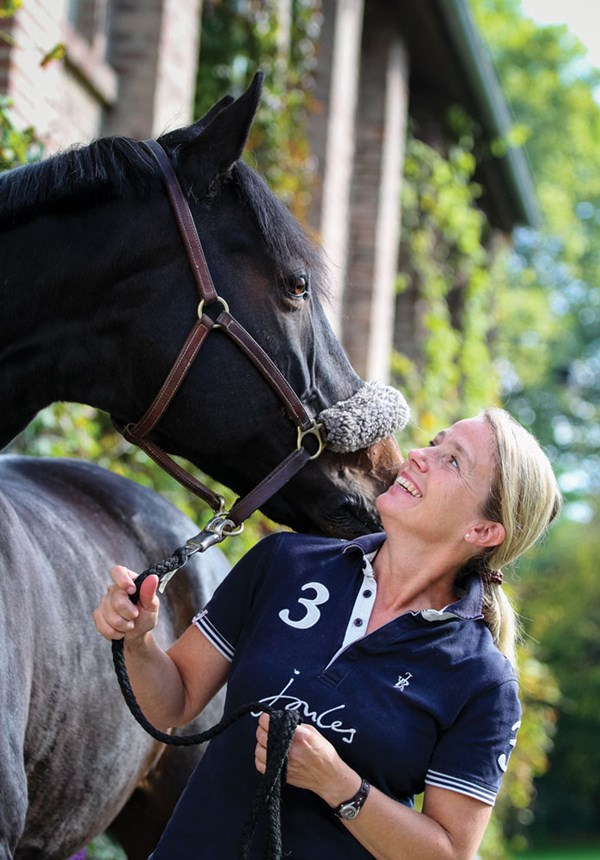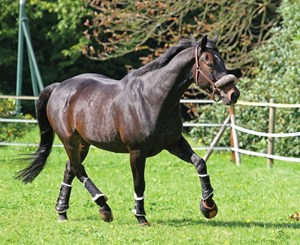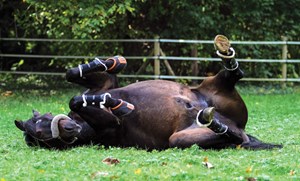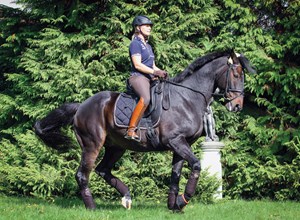In this two-part series, Dressage Today discusses the aging dressage horse and how to best maintain his physical and mental health. In Part 1, we heard from Germany’s dressage Olympian Uta Gräf on how she manages not only her senior dressage horses, but also how she cares for the young ones so that they remain healthy as they age. In Part 2, we hear from German Grand Prix rider Sabine Becker on what she learned from her Oldenburg gelding, Lamarc, and how listening to him helped her to save him from a potentially devastating health problem.

I met Lamarc (aka Marci), who is now 18, when he was a green 4-year-old. A friend had started him under saddle and I began working with this very sensitive Oldenburg gelding when he was almost 5. At that time I was already working as a professional dressage rider and had ridden up to S-level. But I dreamed that one day I would ride a Grand Prix horse.
That dream was fulfilled when Marci was 8. We started in our first-ever Grand Prix in 2006, and with the support of former German national coach Jonny Hilberath, we improved enough to be allowed to compete in the best German CDIs up to the CHIO in Aachen through 2010.
It was an amazing journey and an incredible experience to compete with the very best. I was completely aware that it was due to Lamarc’s limitless work ethic that we could come that far as Grand Prix newcomers. When he placed third in the CDI Grand Prix special at Aachen in 2010 I got very serious offers for him. Even though from a financial standpoint it would have made sense, I just couldn’t part with my equine friend.
Until the international successes came, Lamarc’s training and care were more or less smooth sailing. There were no health problems and I considered him to be a tough animal. The focus with him was the work, not the management of anything special. So it came as a complete shock when his condition began to deteriorate at the end of his fabulous 2010 season. Seemingly out of the blue, he stood in his stall with hanging ears as various symptoms plagued him: diarrhea, nosebleeds, breathlessness, hoof abscesses and loose hoof walls due to a deteriorating horn quality and a swollen left front leg. Every rider who has been in a similar situation can imagine how devastating it is to see one’s own horse suffer, and it was no different for me.
After a rather long time and meticulous investigations, we found out that Lamarc was suffering from a food allergy that caused his metabolism to work improperly, resulting in those unpleasant symptoms. Even though I was very relieved that we finally had a diagnosis we could work with, I was confronted with various problems that had been caused by the allergy. Admittedly, there were challenges I had never dealt with before: supplying a horse with enough energy without oats, determining the course of his long-term hoof care and tailoring his training to build up the lost musculature without putting too much strain on him and his then-fragile hooves.
Looking back, Lamarc’s health crisis turned out to be the starting point of an amazing journey for me. Lamarc’s health problems completely changed my attitude toward horse care because they made me think outside the box. Our journey over the past few years was a difficult one. Yet it also was inspirational because I learned a powerful lesson: Never stop listening to what your horse has to tell you.
Changes in Lamarc’s Diet
Lamarc is a horse with lots of Thoroughbred blood in his veins and though an easy keeper, he was never a big eater. In fact, he often refused to eat all of his oats. Still, for my training regime, oats were the main supplier of energy for a highly trained sport horse. The new challenge was to replace the oats with something that he liked while also providing him with the nutritional equivalent of the oats, which was easier said than done.

Before we could establish a new diet permanently, Lamarc’s intestines had to be completely restored after having dealt with the wrong food for such a long time. With proper research, I found a special diet food by a German feed manufacturer for stabilizing the intestine. I started feeding more and more high-quality roughage with alfalfa, carrots and supplements containing minerals and pre- and probiotics. During this phase, Lamarc continuously lost weight, which unsettled me. It seemed so hard to find the right ration for a sport horse like him. But with careful management, the unpleasant symptoms disappeared and my horse was in high spirits again, which encouraged me to continue this new feed program.
Even though it took many months and meant some weight loss, we slowly got him acclimated to the new oat-free feeding regime. All in all, it took more than a year for him to gain the weight back, but Lamarc still never became as completely round as before his crisis
The Physical Comeback
At the end of 2010, shortly before we discovered Lamarc’s oat allergy, I couldn’t train seriously because he felt unfit. He no longer showed his normal submission and obedience. He just felt unwell and he signaled it to me. The consequence was that he had already lost musculature, which later became even worse with the necessary change in his diet. Therefore, the main aim after the symptoms disappeared and Lamarc could start training again was to build up his musculature and stamina so that he could once again deal with the strength-sapping movements of the Grand Prix.

This process was interrupted now and then by Lamarc’s poor hoof quality which had been caused by the weak metabolism. Of course, everybody knows the cliche, “no hoof, no horse.” This phase, however, takes on new meaning when it is your own horse with the hoof problem.
In Lamarc’s case, he never had very good horn quality, but we shod him regularly with usual shoes with clips to keep them properly affixed. I didn’t really think about the shoeing as long as the shoes stayed on and my horse went well in them. But in the course of Lamarc’s health crisis, the hoof quality got worse and he regularly suffered from hoof abscesses, as his sole was thin and very sensitive. These problems meant interruptions in the usual training and later also in the comeback phase after we discovered his allergy.
We had to take another look at how we wanted to shoe Lamarc since the clips weren’t allowing his hoof capsule to spread and then tighten again, thus disturbing his hoof mechanism. Removing those clips helped make his loose walls a thing of the past. It also decreased the amount of hoof abscesses. During this phase, Lamarc remained in the stable and was exercised three times a day, every day: I started with 20 minutes of walk and then gradually added up to 10 minutes of trot in the morning.

After a few weeks, we increased this training slowly up to 40 minutes. In the afternoons Lamarc was hacked at a walk. Later we were allowed to add a bit of slow trot and after a few more weeks I cantered him in a forward seat. He enjoyed cantering tremendously, and his delight showed me that he was on the road to full recovery. Additionally, he was put in his paddock for a few hours, where he could move on his own. This also helped to keep him mentally happy and content. I was quite surprised that he built up a good part of his musculature and his fitness rather quickly.
Until the end of his career, at the age of 17, in 2013, I kept the focus on keeping him fit and supple. I took into account that his feed provided less energy and didn’t work him too much at home. One of my first international shows after Lamarc’s crisis was in the summer of 2011 at the CDI Falsterbo in Sweden. To my utter delight, he won the freestyle there. In our first season back after his health problems, I was really happy whenever Lamarc showed his old exuberance again, even though this might have cost us a few points in the arena. All things considered, the lost placing meant very little compared to the renewed vitality and energy of my horse.
Listen To Your Horse
I am eternally grateful to Lamarc for the many different things he has taught me; as a person and as a rider. But above all, he made me listen much more to my horses, to observe them much more carefully and to interpret their gestures more sensibly.

My riding has become more fun since I have begun to better understand what my horses need to perform well. This includes their feeding, training and stable care. Of course, careful management of a horse’s needs in the stable doesn’t mean that one can neglect the riding. One still has to ride well, but to bring out the best of every horse, both are necessary. In my opinion, it pays off competitively and emotionally if we look at our horses as partners and friends. A horse that is in good spirits mentally and physically, whose body is pain-free and allowed to move naturally, makes it so much easier and more fun for the rider.

International German Grand Prix rider Sabine Becker has been a professional since the age of 18. She trained with renowned German dressage trainer Hermann Gösmeier for 17 years before she started training with German national co-coach Jonny Hilberath nine years ago. With her Oldenburg gelding Lamarc, Becker was on the German B-team for several years and placed highly at some of the most important CDI shows in Europe. Currently she is working in a private dressage stable near Bonn, Germany.
Diagnosing Food Allergies
While food allergies in canines tend to be common, the same does not hold true for other companion animals. “In fact, food allergies in horses are quite uncommon,” says Kathy Williamson, DVM, and manager of veterinary services for Purina Animal Nutrition, LLC. “There are very few documented cases of food allergies, and horse owners are often given a misdiagnosis.”
Many veterinarians will use a blood-serum test to diagnose horses who appear to be allergic to something in their environment. But according to Williamson, this serum test is not valid in diagnosing food allergies and often produces a false positive result. “The only proper way to know if a horse has a feed allergy is to perform a food-elimination trial,” says Williamson. “To make sure the trial is successful, the horse must be symptomatic at the time you begin. You start by placing the horse on a strict diet of grass hay only and eliminating all other feedstuffs. If the horse becomes asymptomatic, then you can add back the concentrate portion of the diet for one to two weeks to see if the problems return. If they do, you then break down the diet’s ingredients, feeding them back one by one to see what might be causing the problems. It is a very cumbersome and time-consuming process,” Williamson adds.
Williamson does offer three tips to help owners identify if a horse might be suffering from a food allergy. She says a food allergy:
1. will not be seasonal; it will last throughout the year.
2. will not wax and wane. The only time this may be the case is if an owner switches feed often. That said, most feeds have the same ingredients, and a horse will maintain his allergic state through feed changes.
3. will manifest in traditional ailments such as hives, mild colic or chronic diarrhea.
Fit as a Fiddle
From the look of his alert, big dark eyes, Lamarc still seems to be the same as he was 10 years ago. Nearing his 19th birthday, the Oldenburg gelding, who was retired one year ago, does not seem to have aged at all.

Now only ridden occasionally, he spends most of his time in a field with his pony friend Primel. There it becomes most obvious that all the efforts his rider, Grand Prix competitor Sabine Becker, put into Lamarc over the years still pay off: It is not a stiff and mentally old horse presenting himself to the onlooker. Instead, he does not differ at all from a youngster. When Lamarc bounces over his grassy field and falls into an extended trot, there is still the same sparkle and smoothness in his movements as years ago at Aachen.
When Sabine jumps on her long-time partner and asks him to piaffe for my camera, Lamarc does not hesitate for a moment, even though he hasn’t done it for months. Like the pro that he is, he sits on his hind legs and lifts his legs in elevated diagonal steps. In fact, he needs some gentle persuasion to understand that he must not go on with it forever.
It speaks volumes of Sabine’s attitude toward him that she does not think for a moment to pull him out of retirement despite her horse being in remarkable physical and outstanding mental condition, thanks to her relentless efforts over the past years. “Lamarc has done a world of good for me,” she says. “What could be more rewarding than seeing him enjoying his retirement not as a really old horse in which every steps hurts, but still living a life full of joy?”











